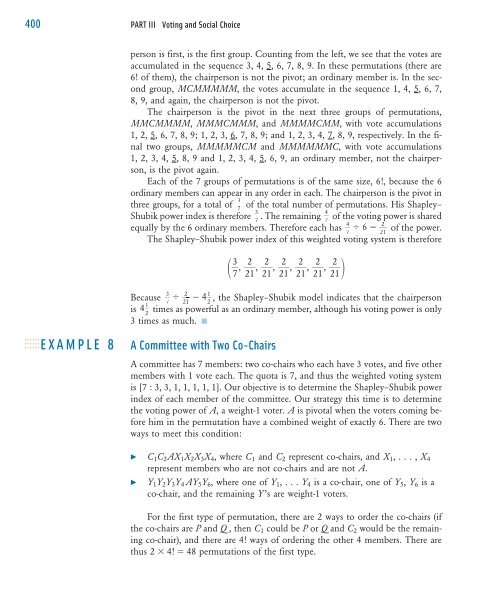Weighted Voting Systems - W.H. Freeman
Weighted Voting Systems - W.H. Freeman
Weighted Voting Systems - W.H. Freeman
- No tags were found...
You also want an ePaper? Increase the reach of your titles
YUMPU automatically turns print PDFs into web optimized ePapers that Google loves.
400 PART III <strong>Voting</strong> and Social Choiceperson is first, is the first group. Counting from the left, we see that the votes areaccumulated in the sequence 3, 4, 5, 6, 7, 8, 9. In these permutations (there are6! of them), the chairperson is not the pivot; an ordinary member is. In the secondgroup, MCMMMMM, the votes accumulate in the sequence 1, 4, 5, 6, 7,8, 9, and again, the chairperson is not the pivot.The chairperson is the pivot in the next three groups of permutations,MMCMMMM, MMMCMMM, and MMMMCMM, with vote accumulations1, 2, 5, 6, 7, 8, 9; 1, 2, 3, 6, 7, 8, 9; and 1, 2, 3, 4, 7, 8, 9, respectively. In the finaltwo groups, MMMMMCM and MMMMMMC, with vote accumulations1, 2, 3, 4, 5, 8, 9 and 1, 2, 3, 4, 5, 6, 9, an ordinary member, not the chairperson,is the pivot again.Each of the 7 groups of permutations is of the same size, 6!, because the 6ordinary members can appear in any order in each. The chairperson is the pivot inthree groups, for a total of 3 7 of the total number of permutations. His Shapley–Shubik power index is therefore 3 . The remaining 4 7 7 of the voting power is sharedequally by the 6 ordinary members. Therefore each hasof the power. 4 7 6 2 2 1The Shapley–Shubik power index of this weighted voting system is therefore 3 7 , 2 2 2 2 2 2, , , , , 212 1 2 1 2 1 2 1 2 1Because 3 , the Shapley–Shubik model indicates that the chairperson7 2 4 1 2 2 is 4 1 times as powerful as an ordinary member, although his voting power is only2 3 times as much. EXAMPLE 8A Committee with Two Co-ChairsA committee has 7 members: two co-chairs who each have 3 votes, and five othermembers with 1 vote each. The quota is 7, and thus the weighted voting systemis [7 : 3, 3, 1, 1, 1, 1, 1]. Our objective is to determine the Shapley–Shubik powerindex of each member of the committee. Our strategy this time is to determinethe voting power of A, a weight-1 voter. A is pivotal when the voters coming beforehim in the permutation have a combined weight of exactly 6. There are twoways to meet this condition: C 1 C 2 AX 1 X 2 X 3 X 4 , where C 1 and C 2 represent co-chairs, and X 1 , . . . , X 4represent members who are not co-chairs and are not A.Y 1 Y 2 Y 3 Y 4 AY 5 Y 6 , where one of Y 1 , . . . Y 4 is a co-chair, one of Y 5 , Y 6 is aco-chair, and the remaining Y ’s are weight-1 voters.For the first type of permutation, there are 2 ways to order the co-chairs (ifthe co-chairs are P and Q , then C 1 could be P or Q and C 2 would be the remainingco-chair), and there are 4! ways of ordering the other 4 members. There arethus 2 4! 48 permutations of the first type.
















